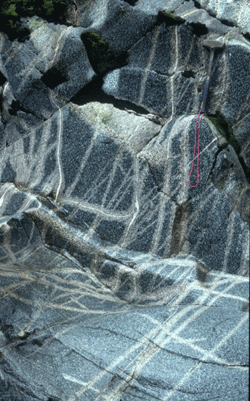Publications
° Daczko, N.R., Clarke, G.L. and Klepeis, K.A. 2001. Transformation of two-pyroxene hornblende granulite to garnet
granulite involving simultaneous melting and
fracturing of the lower crust, Fiordland, New Zealand. Journal of Metamorphic
Geology, 19, 547-560.
Abstract
Granulite facies gabbroic and
dioritic gneiss in the Pembroke Valley, Milford Sound, New Zealand, are cut
by vertical and planar garnet reaction zones in rectilinear patterns. In
gabbroic gneiss, narrow dykes of anorthositic leucosome are surrounded by
fine-grained garnet granulite that patchily recrystallized the host two-pyroxene-hornblende
granulite at conditions of T>750°C and PÅ14 kbar.
Major and trace element whole rock geochemical data indicate that the recrystallization
was essentially isochemical. The garnet reaction zones cut contacts between
the gabbroic gneiss and dioritic gneiss, but change in morphology at the
contacts to zones with a septum of coarse-grained garnet surrounded by anorthositic
leucosome. The dioritic gneiss additionally contains isolated garnet grains
enclosed by leucosome, and short planar trains of garnet grains linked by
spatially restricted leucosome. Partial melting of the dioritic gneiss, mostly
controlled by hornblende breakdown at water-undersaturated conditions, is
inferred to have generated the leucosomes. The form of the leucosomes is
consistent with melt segregation and transport having been aided by fracture
propagation; limited retrogression suggests that there was considerable melt
escape. Dyking and melt escape is inferred to have propagated fractures into
the gabbroic gneiss, where the dioritic gneiss-sourced melt scavenged water
from surrounding rocks and induced the limited recrystallization to garnet
granulite.

|
 ARC Centre of Excellence for Core to Crust Fluid Systems
ARC Centre of Excellence for Core to Crust Fluid Systems